Comparative Financial Analysis of Qantas and Virgin Australia Report
VerifiedAdded on 2021/06/16
|17
|4263
|214
Report
AI Summary
This report presents a comparative financial analysis of Qantas Limited and Virgin Australia, focusing on the years 2016 and 2017. The analysis employs ratio analysis techniques, examining short-term solvency, long-term liquidity, profitability, asset utilization, and market value ratios. The report provides detailed calculations and interpretations for each ratio, including current ratio, quick ratio, capital gearing ratio, interest coverage ratio, debt to total assets ratio, net profit ratio, gross profit ratio, stock turnover ratio, and total asset turnover. The findings highlight the financial strengths and weaknesses of each airline, offering recommendations for potential investors based on the comparative performance across various financial metrics. The report concludes with a summary of the key findings and suggestions for future investment strategies, emphasizing areas where each company excels or needs improvement.
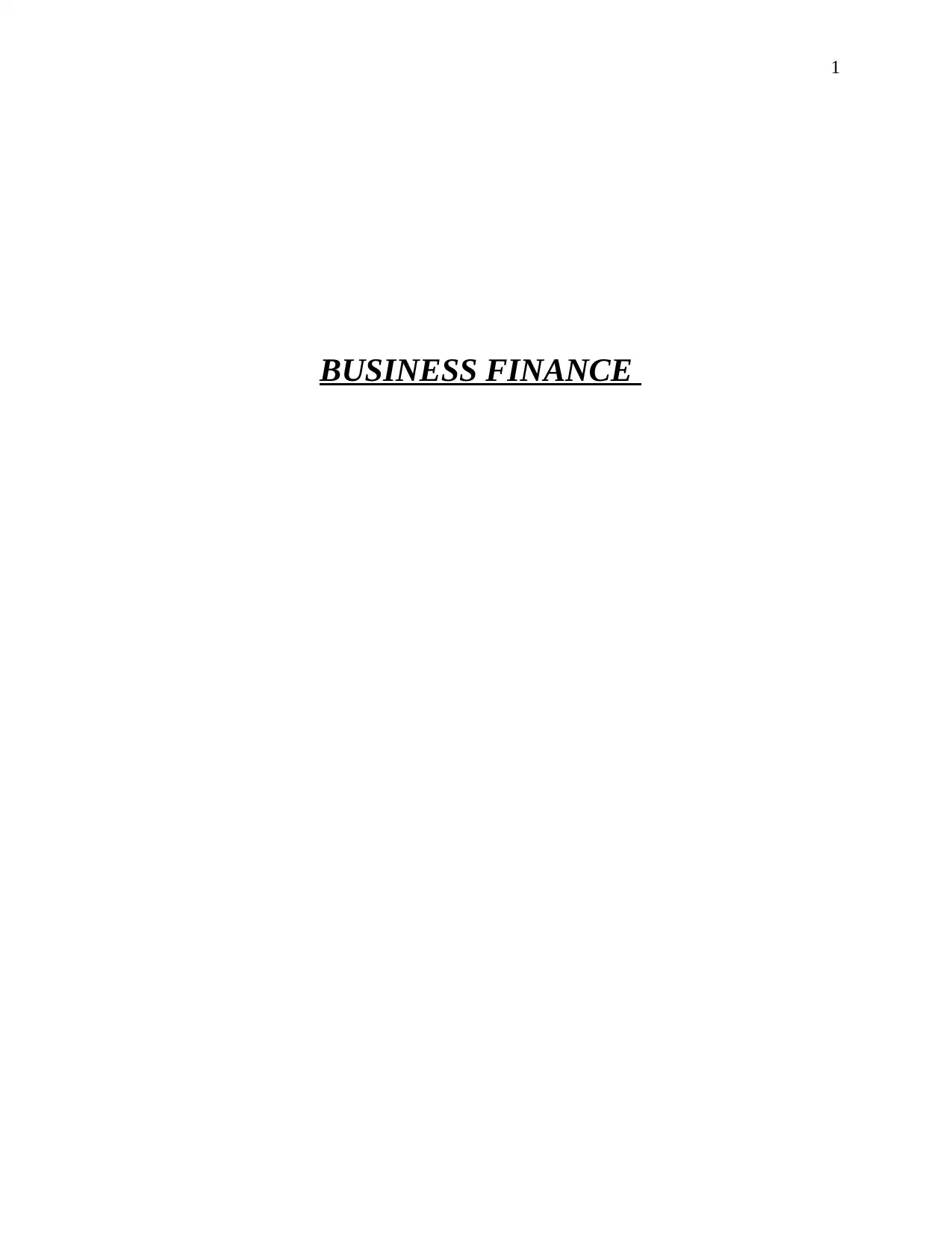
1
BUSINESS FINANCE
BUSINESS FINANCE
Paraphrase This Document
Need a fresh take? Get an instant paraphrase of this document with our AI Paraphraser

2
Contents
Introduction......................................................................................................................................3
Ratio analysis...................................................................................................................................4
Short-term solvency ratios...........................................................................................................4
Long term liquidity ratios............................................................................................................6
Profitability ratios........................................................................................................................8
Asset utilization ratio...................................................................................................................9
Market value ratios....................................................................................................................11
Ratio comparison between Qantas limited and Virgin Australia..................................................12
Conclusion.....................................................................................................................................13
Recommendation...........................................................................................................................14
References......................................................................................................................................16
Contents
Introduction......................................................................................................................................3
Ratio analysis...................................................................................................................................4
Short-term solvency ratios...........................................................................................................4
Long term liquidity ratios............................................................................................................6
Profitability ratios........................................................................................................................8
Asset utilization ratio...................................................................................................................9
Market value ratios....................................................................................................................11
Ratio comparison between Qantas limited and Virgin Australia..................................................12
Conclusion.....................................................................................................................................13
Recommendation...........................................................................................................................14
References......................................................................................................................................16
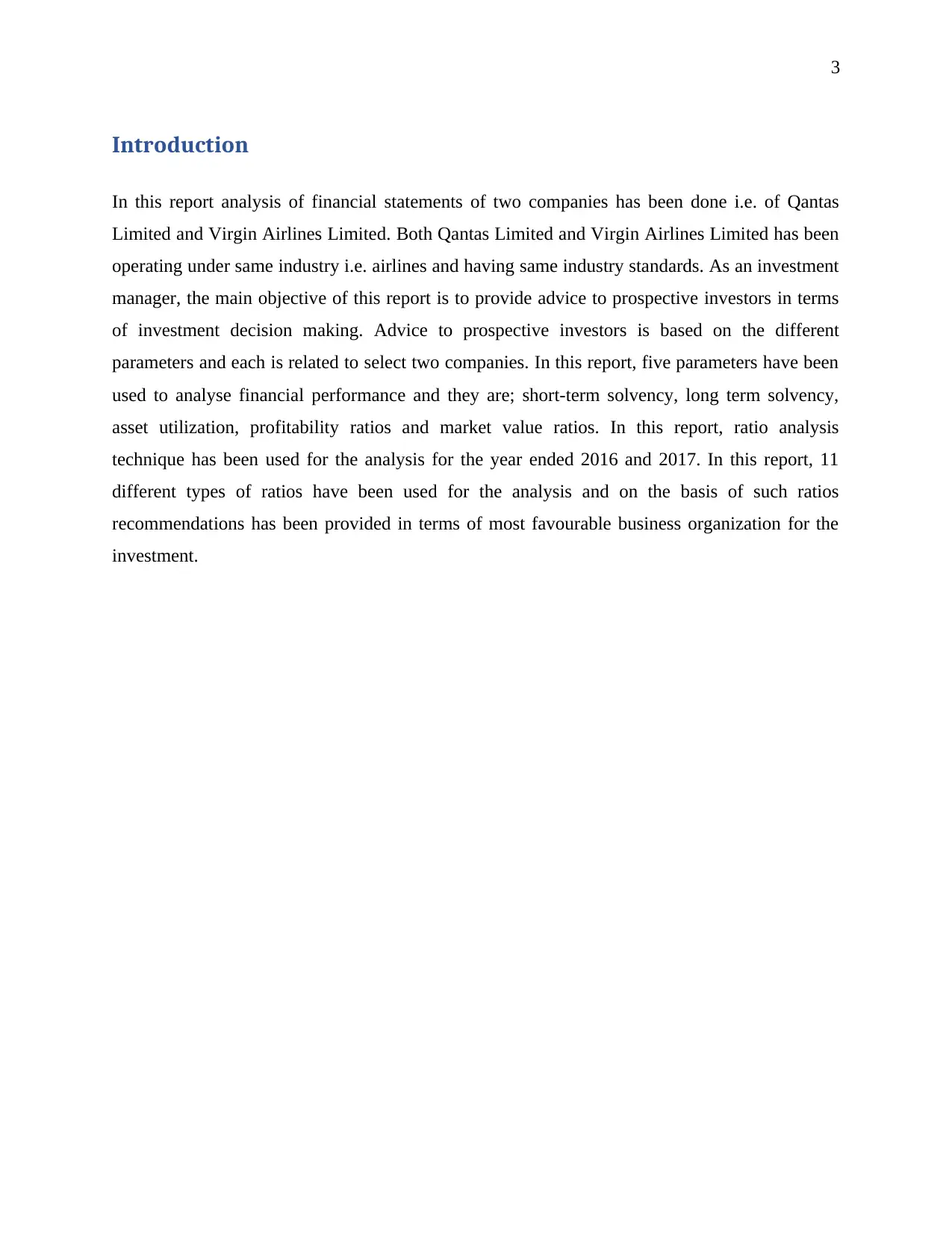
3
Introduction
In this report analysis of financial statements of two companies has been done i.e. of Qantas
Limited and Virgin Airlines Limited. Both Qantas Limited and Virgin Airlines Limited has been
operating under same industry i.e. airlines and having same industry standards. As an investment
manager, the main objective of this report is to provide advice to prospective investors in terms
of investment decision making. Advice to prospective investors is based on the different
parameters and each is related to select two companies. In this report, five parameters have been
used to analyse financial performance and they are; short-term solvency, long term solvency,
asset utilization, profitability ratios and market value ratios. In this report, ratio analysis
technique has been used for the analysis for the year ended 2016 and 2017. In this report, 11
different types of ratios have been used for the analysis and on the basis of such ratios
recommendations has been provided in terms of most favourable business organization for the
investment.
Introduction
In this report analysis of financial statements of two companies has been done i.e. of Qantas
Limited and Virgin Airlines Limited. Both Qantas Limited and Virgin Airlines Limited has been
operating under same industry i.e. airlines and having same industry standards. As an investment
manager, the main objective of this report is to provide advice to prospective investors in terms
of investment decision making. Advice to prospective investors is based on the different
parameters and each is related to select two companies. In this report, five parameters have been
used to analyse financial performance and they are; short-term solvency, long term solvency,
asset utilization, profitability ratios and market value ratios. In this report, ratio analysis
technique has been used for the analysis for the year ended 2016 and 2017. In this report, 11
different types of ratios have been used for the analysis and on the basis of such ratios
recommendations has been provided in terms of most favourable business organization for the
investment.
⊘ This is a preview!⊘
Do you want full access?
Subscribe today to unlock all pages.

Trusted by 1+ million students worldwide
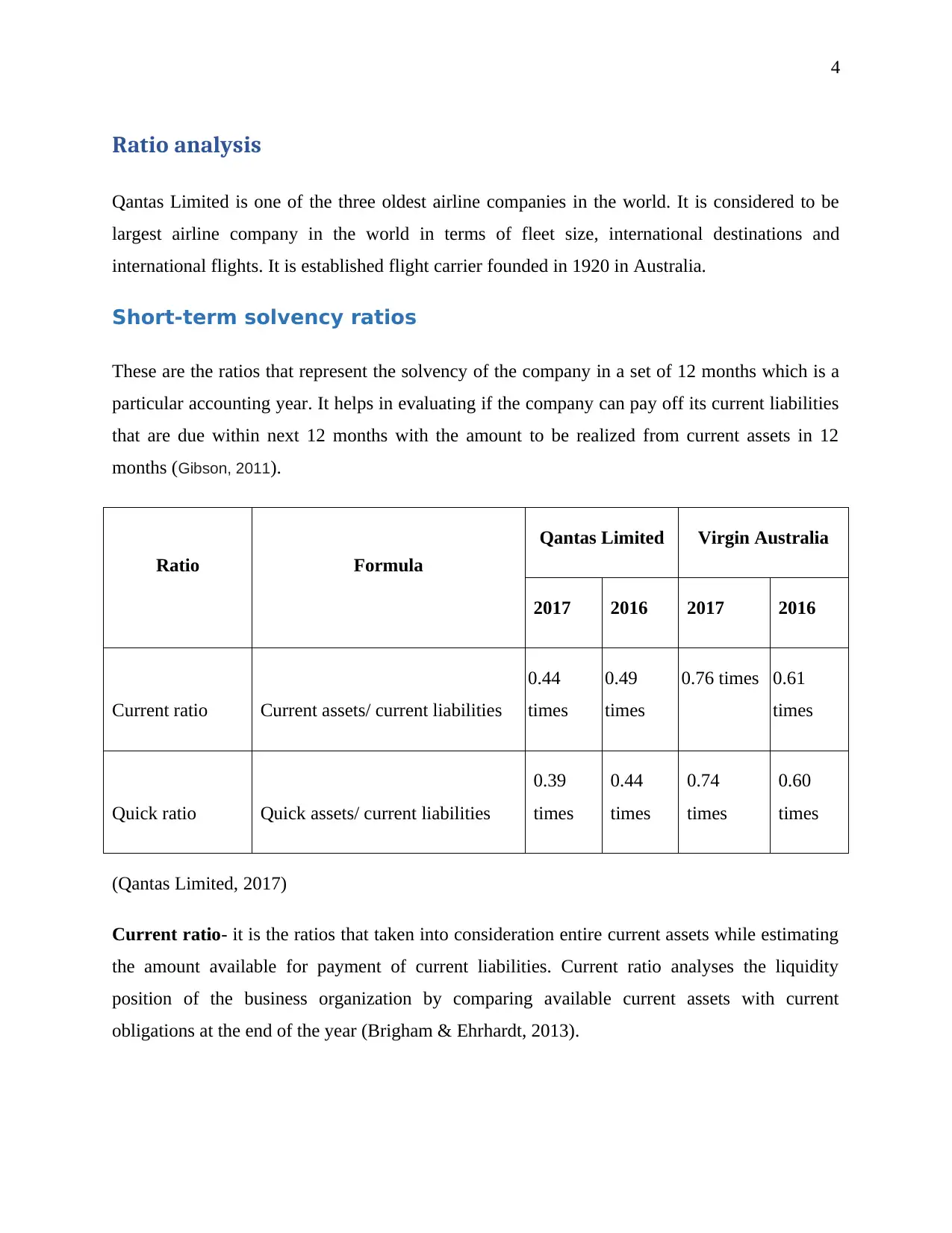
4
Ratio analysis
Qantas Limited is one of the three oldest airline companies in the world. It is considered to be
largest airline company in the world in terms of fleet size, international destinations and
international flights. It is established flight carrier founded in 1920 in Australia.
Short-term solvency ratios
These are the ratios that represent the solvency of the company in a set of 12 months which is a
particular accounting year. It helps in evaluating if the company can pay off its current liabilities
that are due within next 12 months with the amount to be realized from current assets in 12
months (Gibson, 2011).
Ratio Formula
Qantas Limited Virgin Australia
2017 2016 2017 2016
Current ratio Current assets/ current liabilities
0.44
times
0.49
times
0.76 times 0.61
times
Quick ratio Quick assets/ current liabilities
0.39
times
0.44
times
0.74
times
0.60
times
(Qantas Limited, 2017)
Current ratio- it is the ratios that taken into consideration entire current assets while estimating
the amount available for payment of current liabilities. Current ratio analyses the liquidity
position of the business organization by comparing available current assets with current
obligations at the end of the year (Brigham & Ehrhardt, 2013).
Ratio analysis
Qantas Limited is one of the three oldest airline companies in the world. It is considered to be
largest airline company in the world in terms of fleet size, international destinations and
international flights. It is established flight carrier founded in 1920 in Australia.
Short-term solvency ratios
These are the ratios that represent the solvency of the company in a set of 12 months which is a
particular accounting year. It helps in evaluating if the company can pay off its current liabilities
that are due within next 12 months with the amount to be realized from current assets in 12
months (Gibson, 2011).
Ratio Formula
Qantas Limited Virgin Australia
2017 2016 2017 2016
Current ratio Current assets/ current liabilities
0.44
times
0.49
times
0.76 times 0.61
times
Quick ratio Quick assets/ current liabilities
0.39
times
0.44
times
0.74
times
0.60
times
(Qantas Limited, 2017)
Current ratio- it is the ratios that taken into consideration entire current assets while estimating
the amount available for payment of current liabilities. Current ratio analyses the liquidity
position of the business organization by comparing available current assets with current
obligations at the end of the year (Brigham & Ehrhardt, 2013).
Paraphrase This Document
Need a fresh take? Get an instant paraphrase of this document with our AI Paraphraser
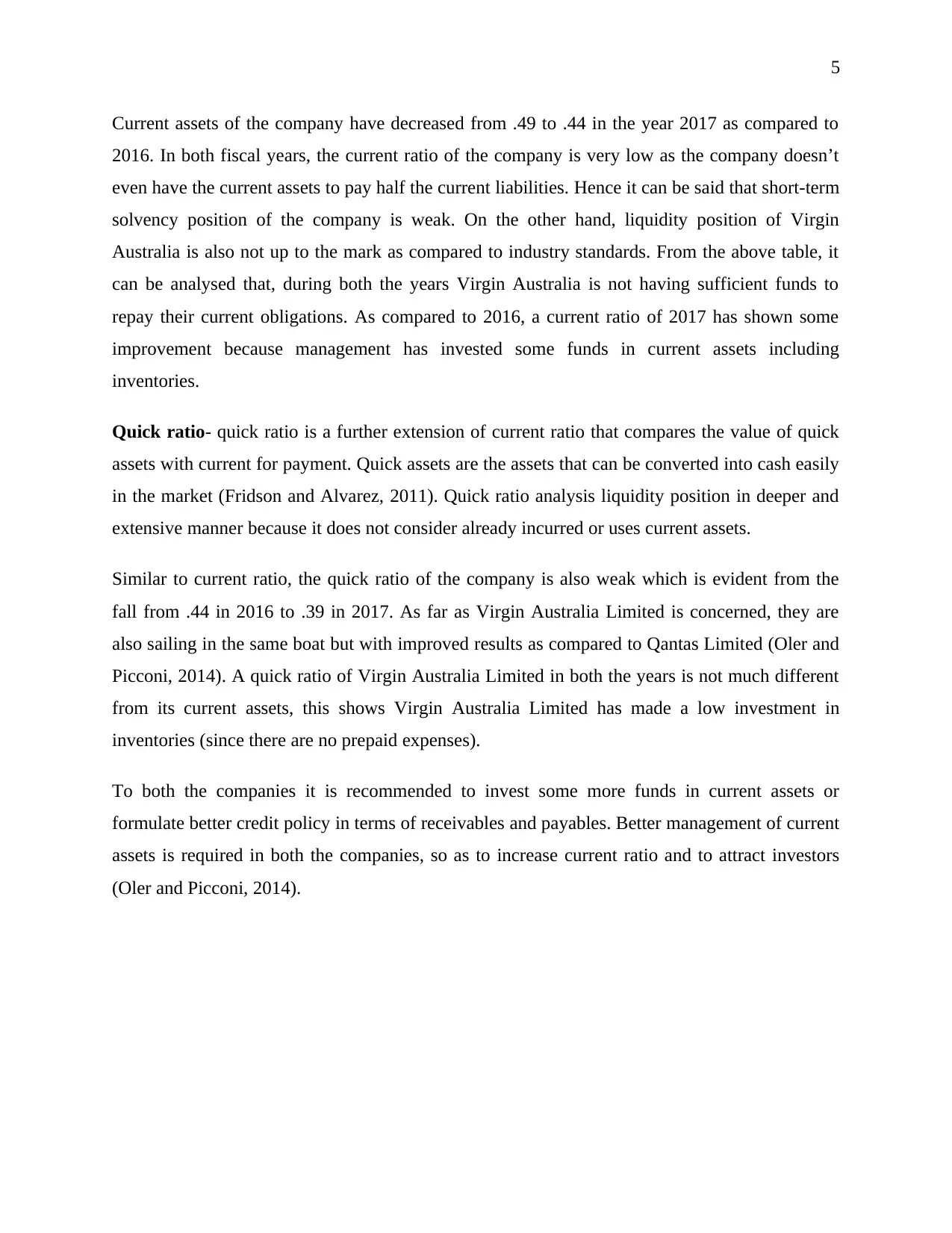
5
Current assets of the company have decreased from .49 to .44 in the year 2017 as compared to
2016. In both fiscal years, the current ratio of the company is very low as the company doesn’t
even have the current assets to pay half the current liabilities. Hence it can be said that short-term
solvency position of the company is weak. On the other hand, liquidity position of Virgin
Australia is also not up to the mark as compared to industry standards. From the above table, it
can be analysed that, during both the years Virgin Australia is not having sufficient funds to
repay their current obligations. As compared to 2016, a current ratio of 2017 has shown some
improvement because management has invested some funds in current assets including
inventories.
Quick ratio- quick ratio is a further extension of current ratio that compares the value of quick
assets with current for payment. Quick assets are the assets that can be converted into cash easily
in the market (Fridson and Alvarez, 2011). Quick ratio analysis liquidity position in deeper and
extensive manner because it does not consider already incurred or uses current assets.
Similar to current ratio, the quick ratio of the company is also weak which is evident from the
fall from .44 in 2016 to .39 in 2017. As far as Virgin Australia Limited is concerned, they are
also sailing in the same boat but with improved results as compared to Qantas Limited (Oler and
Picconi, 2014). A quick ratio of Virgin Australia Limited in both the years is not much different
from its current assets, this shows Virgin Australia Limited has made a low investment in
inventories (since there are no prepaid expenses).
To both the companies it is recommended to invest some more funds in current assets or
formulate better credit policy in terms of receivables and payables. Better management of current
assets is required in both the companies, so as to increase current ratio and to attract investors
(Oler and Picconi, 2014).
Current assets of the company have decreased from .49 to .44 in the year 2017 as compared to
2016. In both fiscal years, the current ratio of the company is very low as the company doesn’t
even have the current assets to pay half the current liabilities. Hence it can be said that short-term
solvency position of the company is weak. On the other hand, liquidity position of Virgin
Australia is also not up to the mark as compared to industry standards. From the above table, it
can be analysed that, during both the years Virgin Australia is not having sufficient funds to
repay their current obligations. As compared to 2016, a current ratio of 2017 has shown some
improvement because management has invested some funds in current assets including
inventories.
Quick ratio- quick ratio is a further extension of current ratio that compares the value of quick
assets with current for payment. Quick assets are the assets that can be converted into cash easily
in the market (Fridson and Alvarez, 2011). Quick ratio analysis liquidity position in deeper and
extensive manner because it does not consider already incurred or uses current assets.
Similar to current ratio, the quick ratio of the company is also weak which is evident from the
fall from .44 in 2016 to .39 in 2017. As far as Virgin Australia Limited is concerned, they are
also sailing in the same boat but with improved results as compared to Qantas Limited (Oler and
Picconi, 2014). A quick ratio of Virgin Australia Limited in both the years is not much different
from its current assets, this shows Virgin Australia Limited has made a low investment in
inventories (since there are no prepaid expenses).
To both the companies it is recommended to invest some more funds in current assets or
formulate better credit policy in terms of receivables and payables. Better management of current
assets is required in both the companies, so as to increase current ratio and to attract investors
(Oler and Picconi, 2014).
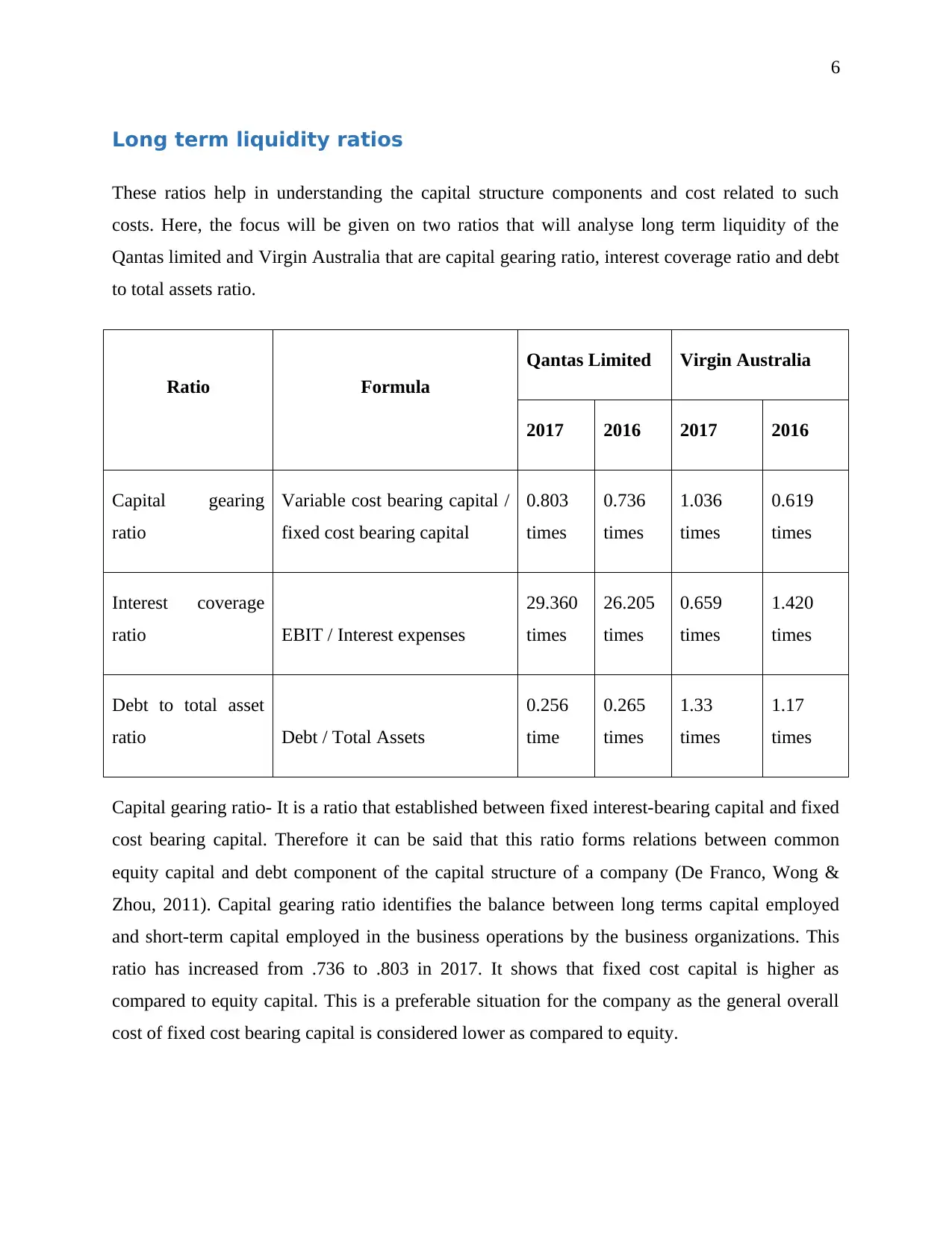
6
Long term liquidity ratios
These ratios help in understanding the capital structure components and cost related to such
costs. Here, the focus will be given on two ratios that will analyse long term liquidity of the
Qantas limited and Virgin Australia that are capital gearing ratio, interest coverage ratio and debt
to total assets ratio.
Ratio Formula
Qantas Limited Virgin Australia
2017 2016 2017 2016
Capital gearing
ratio
Variable cost bearing capital /
fixed cost bearing capital
0.803
times
0.736
times
1.036
times
0.619
times
Interest coverage
ratio EBIT / Interest expenses
29.360
times
26.205
times
0.659
times
1.420
times
Debt to total asset
ratio Debt / Total Assets
0.256
time
0.265
times
1.33
times
1.17
times
Capital gearing ratio- It is a ratio that established between fixed interest-bearing capital and fixed
cost bearing capital. Therefore it can be said that this ratio forms relations between common
equity capital and debt component of the capital structure of a company (De Franco, Wong &
Zhou, 2011). Capital gearing ratio identifies the balance between long terms capital employed
and short-term capital employed in the business operations by the business organizations. This
ratio has increased from .736 to .803 in 2017. It shows that fixed cost capital is higher as
compared to equity capital. This is a preferable situation for the company as the general overall
cost of fixed cost bearing capital is considered lower as compared to equity.
Long term liquidity ratios
These ratios help in understanding the capital structure components and cost related to such
costs. Here, the focus will be given on two ratios that will analyse long term liquidity of the
Qantas limited and Virgin Australia that are capital gearing ratio, interest coverage ratio and debt
to total assets ratio.
Ratio Formula
Qantas Limited Virgin Australia
2017 2016 2017 2016
Capital gearing
ratio
Variable cost bearing capital /
fixed cost bearing capital
0.803
times
0.736
times
1.036
times
0.619
times
Interest coverage
ratio EBIT / Interest expenses
29.360
times
26.205
times
0.659
times
1.420
times
Debt to total asset
ratio Debt / Total Assets
0.256
time
0.265
times
1.33
times
1.17
times
Capital gearing ratio- It is a ratio that established between fixed interest-bearing capital and fixed
cost bearing capital. Therefore it can be said that this ratio forms relations between common
equity capital and debt component of the capital structure of a company (De Franco, Wong &
Zhou, 2011). Capital gearing ratio identifies the balance between long terms capital employed
and short-term capital employed in the business operations by the business organizations. This
ratio has increased from .736 to .803 in 2017. It shows that fixed cost capital is higher as
compared to equity capital. This is a preferable situation for the company as the general overall
cost of fixed cost bearing capital is considered lower as compared to equity.
⊘ This is a preview!⊘
Do you want full access?
Subscribe today to unlock all pages.

Trusted by 1+ million students worldwide
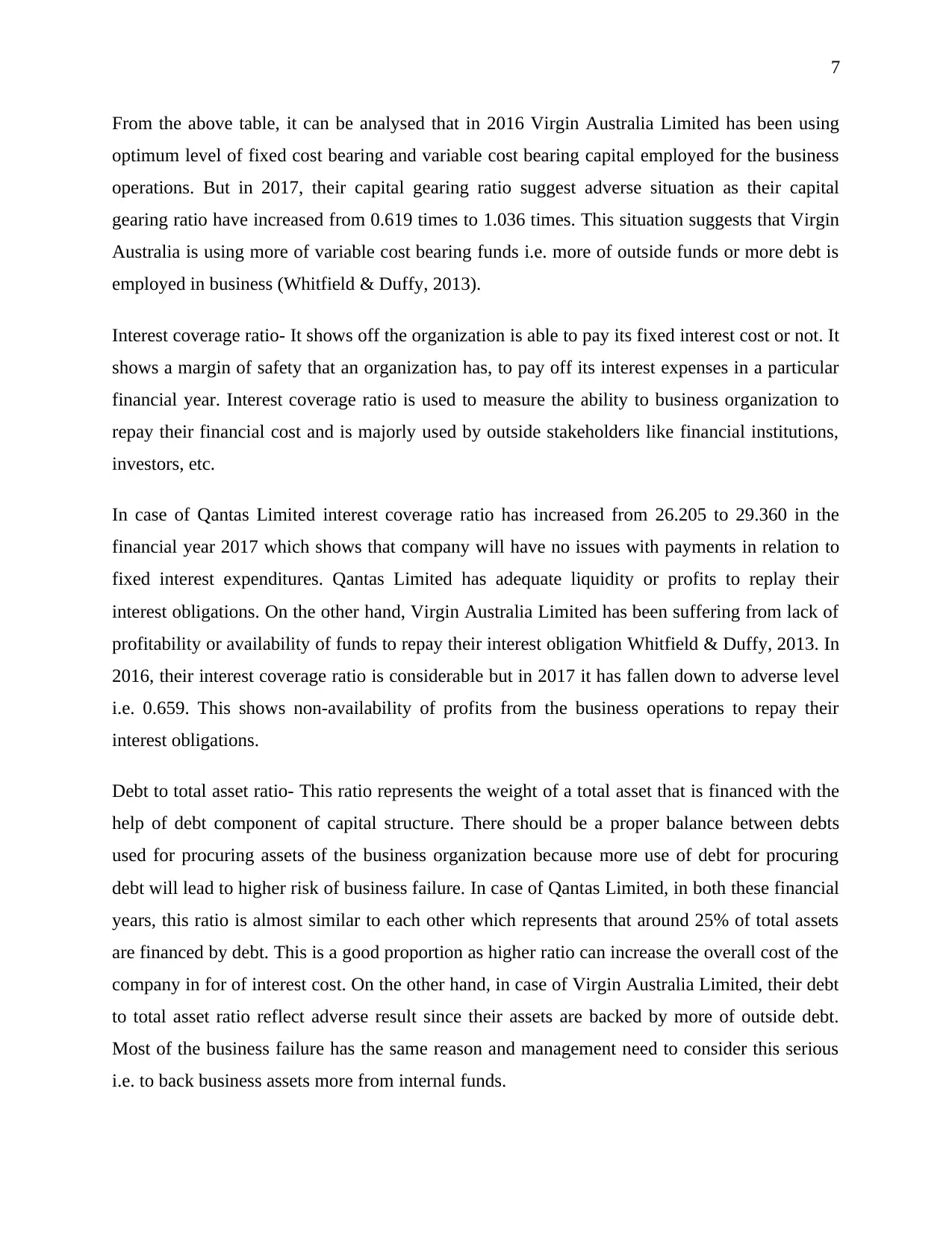
7
From the above table, it can be analysed that in 2016 Virgin Australia Limited has been using
optimum level of fixed cost bearing and variable cost bearing capital employed for the business
operations. But in 2017, their capital gearing ratio suggest adverse situation as their capital
gearing ratio have increased from 0.619 times to 1.036 times. This situation suggests that Virgin
Australia is using more of variable cost bearing funds i.e. more of outside funds or more debt is
employed in business (Whitfield & Duffy, 2013).
Interest coverage ratio- It shows off the organization is able to pay its fixed interest cost or not. It
shows a margin of safety that an organization has, to pay off its interest expenses in a particular
financial year. Interest coverage ratio is used to measure the ability to business organization to
repay their financial cost and is majorly used by outside stakeholders like financial institutions,
investors, etc.
In case of Qantas Limited interest coverage ratio has increased from 26.205 to 29.360 in the
financial year 2017 which shows that company will have no issues with payments in relation to
fixed interest expenditures. Qantas Limited has adequate liquidity or profits to replay their
interest obligations. On the other hand, Virgin Australia Limited has been suffering from lack of
profitability or availability of funds to repay their interest obligation Whitfield & Duffy, 2013. In
2016, their interest coverage ratio is considerable but in 2017 it has fallen down to adverse level
i.e. 0.659. This shows non-availability of profits from the business operations to repay their
interest obligations.
Debt to total asset ratio- This ratio represents the weight of a total asset that is financed with the
help of debt component of capital structure. There should be a proper balance between debts
used for procuring assets of the business organization because more use of debt for procuring
debt will lead to higher risk of business failure. In case of Qantas Limited, in both these financial
years, this ratio is almost similar to each other which represents that around 25% of total assets
are financed by debt. This is a good proportion as higher ratio can increase the overall cost of the
company in for of interest cost. On the other hand, in case of Virgin Australia Limited, their debt
to total asset ratio reflect adverse result since their assets are backed by more of outside debt.
Most of the business failure has the same reason and management need to consider this serious
i.e. to back business assets more from internal funds.
From the above table, it can be analysed that in 2016 Virgin Australia Limited has been using
optimum level of fixed cost bearing and variable cost bearing capital employed for the business
operations. But in 2017, their capital gearing ratio suggest adverse situation as their capital
gearing ratio have increased from 0.619 times to 1.036 times. This situation suggests that Virgin
Australia is using more of variable cost bearing funds i.e. more of outside funds or more debt is
employed in business (Whitfield & Duffy, 2013).
Interest coverage ratio- It shows off the organization is able to pay its fixed interest cost or not. It
shows a margin of safety that an organization has, to pay off its interest expenses in a particular
financial year. Interest coverage ratio is used to measure the ability to business organization to
repay their financial cost and is majorly used by outside stakeholders like financial institutions,
investors, etc.
In case of Qantas Limited interest coverage ratio has increased from 26.205 to 29.360 in the
financial year 2017 which shows that company will have no issues with payments in relation to
fixed interest expenditures. Qantas Limited has adequate liquidity or profits to replay their
interest obligations. On the other hand, Virgin Australia Limited has been suffering from lack of
profitability or availability of funds to repay their interest obligation Whitfield & Duffy, 2013. In
2016, their interest coverage ratio is considerable but in 2017 it has fallen down to adverse level
i.e. 0.659. This shows non-availability of profits from the business operations to repay their
interest obligations.
Debt to total asset ratio- This ratio represents the weight of a total asset that is financed with the
help of debt component of capital structure. There should be a proper balance between debts
used for procuring assets of the business organization because more use of debt for procuring
debt will lead to higher risk of business failure. In case of Qantas Limited, in both these financial
years, this ratio is almost similar to each other which represents that around 25% of total assets
are financed by debt. This is a good proportion as higher ratio can increase the overall cost of the
company in for of interest cost. On the other hand, in case of Virgin Australia Limited, their debt
to total asset ratio reflect adverse result since their assets are backed by more of outside debt.
Most of the business failure has the same reason and management need to consider this serious
i.e. to back business assets more from internal funds.
Paraphrase This Document
Need a fresh take? Get an instant paraphrase of this document with our AI Paraphraser
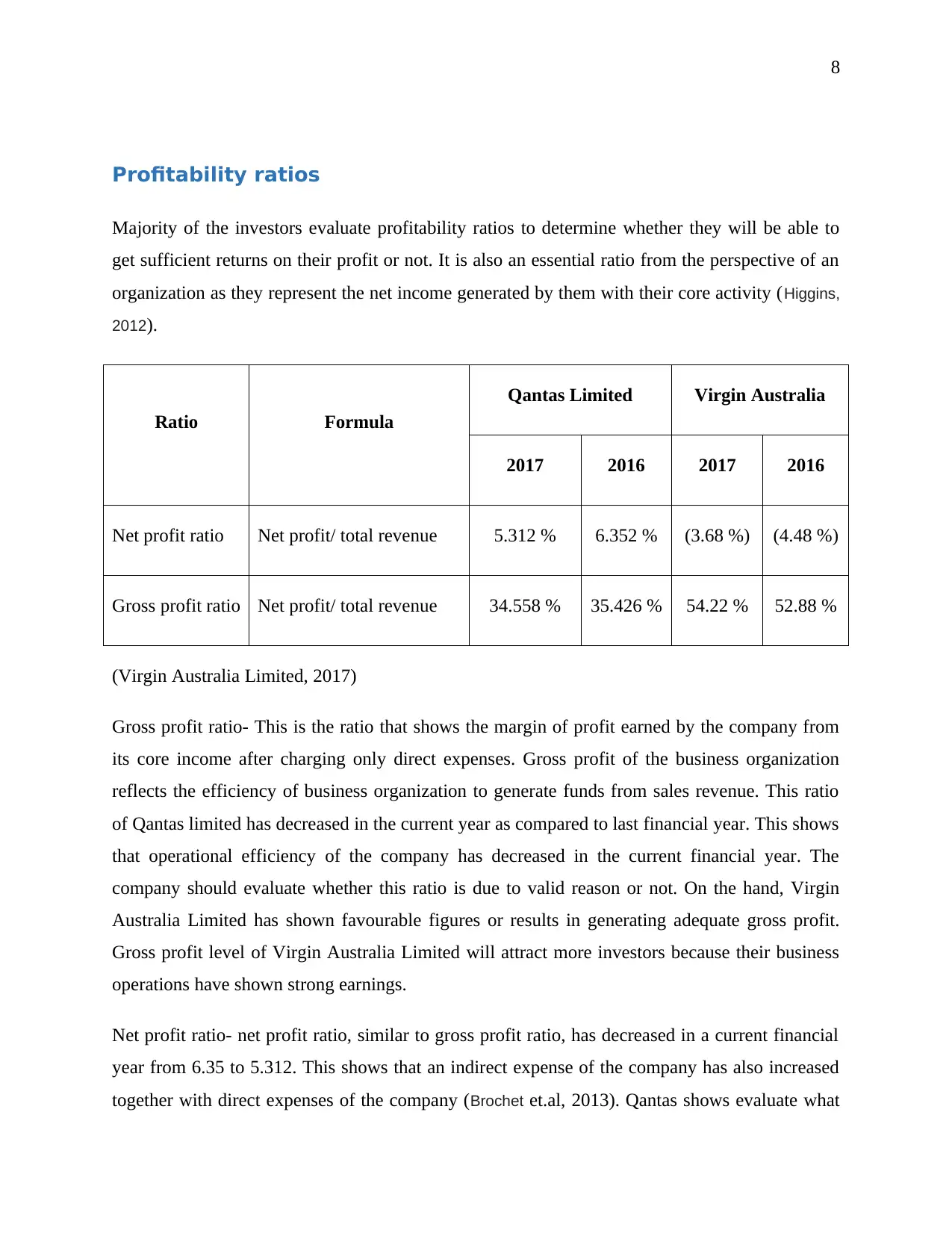
8
Profitability ratios
Majority of the investors evaluate profitability ratios to determine whether they will be able to
get sufficient returns on their profit or not. It is also an essential ratio from the perspective of an
organization as they represent the net income generated by them with their core activity (Higgins,
2012).
Ratio Formula
Qantas Limited Virgin Australia
2017 2016 2017 2016
Net profit ratio Net profit/ total revenue 5.312 % 6.352 % (3.68 %) (4.48 %)
Gross profit ratio Net profit/ total revenue 34.558 % 35.426 % 54.22 % 52.88 %
(Virgin Australia Limited, 2017)
Gross profit ratio- This is the ratio that shows the margin of profit earned by the company from
its core income after charging only direct expenses. Gross profit of the business organization
reflects the efficiency of business organization to generate funds from sales revenue. This ratio
of Qantas limited has decreased in the current year as compared to last financial year. This shows
that operational efficiency of the company has decreased in the current financial year. The
company should evaluate whether this ratio is due to valid reason or not. On the hand, Virgin
Australia Limited has shown favourable figures or results in generating adequate gross profit.
Gross profit level of Virgin Australia Limited will attract more investors because their business
operations have shown strong earnings.
Net profit ratio- net profit ratio, similar to gross profit ratio, has decreased in a current financial
year from 6.35 to 5.312. This shows that an indirect expense of the company has also increased
together with direct expenses of the company (Brochet et.al, 2013). Qantas shows evaluate what
Profitability ratios
Majority of the investors evaluate profitability ratios to determine whether they will be able to
get sufficient returns on their profit or not. It is also an essential ratio from the perspective of an
organization as they represent the net income generated by them with their core activity (Higgins,
2012).
Ratio Formula
Qantas Limited Virgin Australia
2017 2016 2017 2016
Net profit ratio Net profit/ total revenue 5.312 % 6.352 % (3.68 %) (4.48 %)
Gross profit ratio Net profit/ total revenue 34.558 % 35.426 % 54.22 % 52.88 %
(Virgin Australia Limited, 2017)
Gross profit ratio- This is the ratio that shows the margin of profit earned by the company from
its core income after charging only direct expenses. Gross profit of the business organization
reflects the efficiency of business organization to generate funds from sales revenue. This ratio
of Qantas limited has decreased in the current year as compared to last financial year. This shows
that operational efficiency of the company has decreased in the current financial year. The
company should evaluate whether this ratio is due to valid reason or not. On the hand, Virgin
Australia Limited has shown favourable figures or results in generating adequate gross profit.
Gross profit level of Virgin Australia Limited will attract more investors because their business
operations have shown strong earnings.
Net profit ratio- net profit ratio, similar to gross profit ratio, has decreased in a current financial
year from 6.35 to 5.312. This shows that an indirect expense of the company has also increased
together with direct expenses of the company (Brochet et.al, 2013). Qantas shows evaluate what
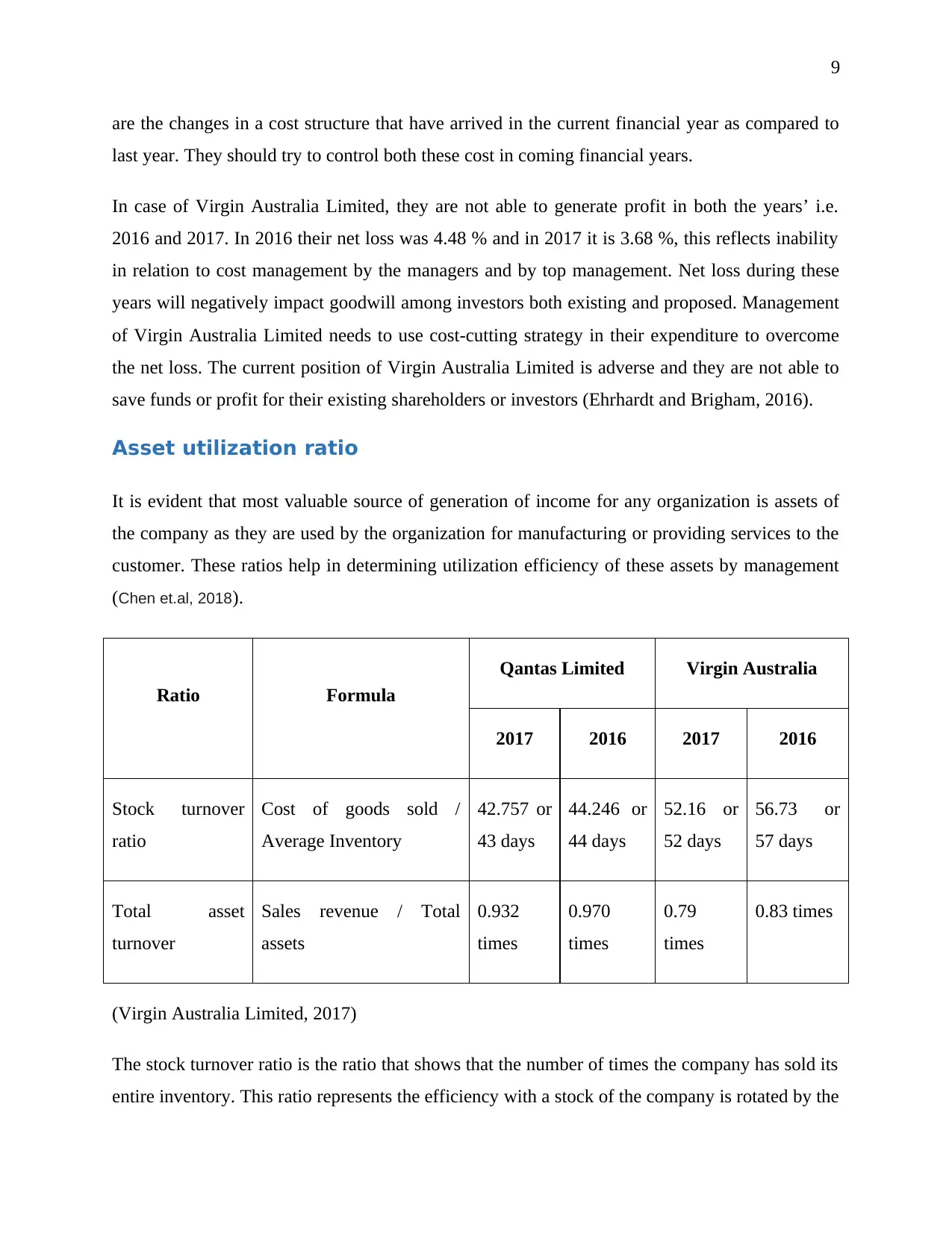
9
are the changes in a cost structure that have arrived in the current financial year as compared to
last year. They should try to control both these cost in coming financial years.
In case of Virgin Australia Limited, they are not able to generate profit in both the years’ i.e.
2016 and 2017. In 2016 their net loss was 4.48 % and in 2017 it is 3.68 %, this reflects inability
in relation to cost management by the managers and by top management. Net loss during these
years will negatively impact goodwill among investors both existing and proposed. Management
of Virgin Australia Limited needs to use cost-cutting strategy in their expenditure to overcome
the net loss. The current position of Virgin Australia Limited is adverse and they are not able to
save funds or profit for their existing shareholders or investors (Ehrhardt and Brigham, 2016).
Asset utilization ratio
It is evident that most valuable source of generation of income for any organization is assets of
the company as they are used by the organization for manufacturing or providing services to the
customer. These ratios help in determining utilization efficiency of these assets by management
(Chen et.al, 2018).
Ratio Formula
Qantas Limited Virgin Australia
2017 2016 2017 2016
Stock turnover
ratio
Cost of goods sold /
Average Inventory
42.757 or
43 days
44.246 or
44 days
52.16 or
52 days
56.73 or
57 days
Total asset
turnover
Sales revenue / Total
assets
0.932
times
0.970
times
0.79
times
0.83 times
(Virgin Australia Limited, 2017)
The stock turnover ratio is the ratio that shows that the number of times the company has sold its
entire inventory. This ratio represents the efficiency with a stock of the company is rotated by the
are the changes in a cost structure that have arrived in the current financial year as compared to
last year. They should try to control both these cost in coming financial years.
In case of Virgin Australia Limited, they are not able to generate profit in both the years’ i.e.
2016 and 2017. In 2016 their net loss was 4.48 % and in 2017 it is 3.68 %, this reflects inability
in relation to cost management by the managers and by top management. Net loss during these
years will negatively impact goodwill among investors both existing and proposed. Management
of Virgin Australia Limited needs to use cost-cutting strategy in their expenditure to overcome
the net loss. The current position of Virgin Australia Limited is adverse and they are not able to
save funds or profit for their existing shareholders or investors (Ehrhardt and Brigham, 2016).
Asset utilization ratio
It is evident that most valuable source of generation of income for any organization is assets of
the company as they are used by the organization for manufacturing or providing services to the
customer. These ratios help in determining utilization efficiency of these assets by management
(Chen et.al, 2018).
Ratio Formula
Qantas Limited Virgin Australia
2017 2016 2017 2016
Stock turnover
ratio
Cost of goods sold /
Average Inventory
42.757 or
43 days
44.246 or
44 days
52.16 or
52 days
56.73 or
57 days
Total asset
turnover
Sales revenue / Total
assets
0.932
times
0.970
times
0.79
times
0.83 times
(Virgin Australia Limited, 2017)
The stock turnover ratio is the ratio that shows that the number of times the company has sold its
entire inventory. This ratio represents the efficiency with a stock of the company is rotated by the
⊘ This is a preview!⊘
Do you want full access?
Subscribe today to unlock all pages.

Trusted by 1+ million students worldwide
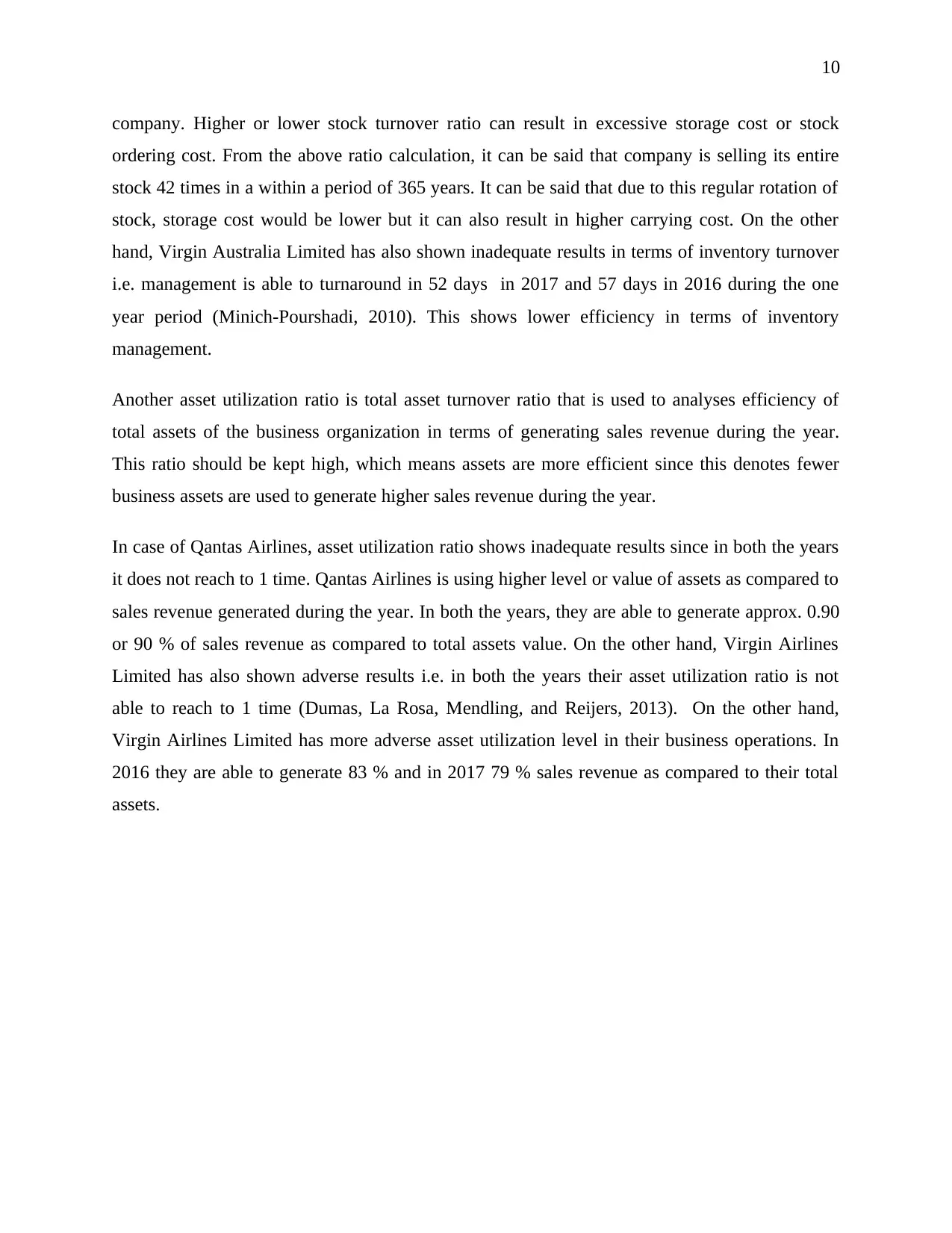
10
company. Higher or lower stock turnover ratio can result in excessive storage cost or stock
ordering cost. From the above ratio calculation, it can be said that company is selling its entire
stock 42 times in a within a period of 365 years. It can be said that due to this regular rotation of
stock, storage cost would be lower but it can also result in higher carrying cost. On the other
hand, Virgin Australia Limited has also shown inadequate results in terms of inventory turnover
i.e. management is able to turnaround in 52 days in 2017 and 57 days in 2016 during the one
year period (Minich-Pourshadi, 2010). This shows lower efficiency in terms of inventory
management.
Another asset utilization ratio is total asset turnover ratio that is used to analyses efficiency of
total assets of the business organization in terms of generating sales revenue during the year.
This ratio should be kept high, which means assets are more efficient since this denotes fewer
business assets are used to generate higher sales revenue during the year.
In case of Qantas Airlines, asset utilization ratio shows inadequate results since in both the years
it does not reach to 1 time. Qantas Airlines is using higher level or value of assets as compared to
sales revenue generated during the year. In both the years, they are able to generate approx. 0.90
or 90 % of sales revenue as compared to total assets value. On the other hand, Virgin Airlines
Limited has also shown adverse results i.e. in both the years their asset utilization ratio is not
able to reach to 1 time (Dumas, La Rosa, Mendling, and Reijers, 2013). On the other hand,
Virgin Airlines Limited has more adverse asset utilization level in their business operations. In
2016 they are able to generate 83 % and in 2017 79 % sales revenue as compared to their total
assets.
company. Higher or lower stock turnover ratio can result in excessive storage cost or stock
ordering cost. From the above ratio calculation, it can be said that company is selling its entire
stock 42 times in a within a period of 365 years. It can be said that due to this regular rotation of
stock, storage cost would be lower but it can also result in higher carrying cost. On the other
hand, Virgin Australia Limited has also shown inadequate results in terms of inventory turnover
i.e. management is able to turnaround in 52 days in 2017 and 57 days in 2016 during the one
year period (Minich-Pourshadi, 2010). This shows lower efficiency in terms of inventory
management.
Another asset utilization ratio is total asset turnover ratio that is used to analyses efficiency of
total assets of the business organization in terms of generating sales revenue during the year.
This ratio should be kept high, which means assets are more efficient since this denotes fewer
business assets are used to generate higher sales revenue during the year.
In case of Qantas Airlines, asset utilization ratio shows inadequate results since in both the years
it does not reach to 1 time. Qantas Airlines is using higher level or value of assets as compared to
sales revenue generated during the year. In both the years, they are able to generate approx. 0.90
or 90 % of sales revenue as compared to total assets value. On the other hand, Virgin Airlines
Limited has also shown adverse results i.e. in both the years their asset utilization ratio is not
able to reach to 1 time (Dumas, La Rosa, Mendling, and Reijers, 2013). On the other hand,
Virgin Airlines Limited has more adverse asset utilization level in their business operations. In
2016 they are able to generate 83 % and in 2017 79 % sales revenue as compared to their total
assets.
Paraphrase This Document
Need a fresh take? Get an instant paraphrase of this document with our AI Paraphraser
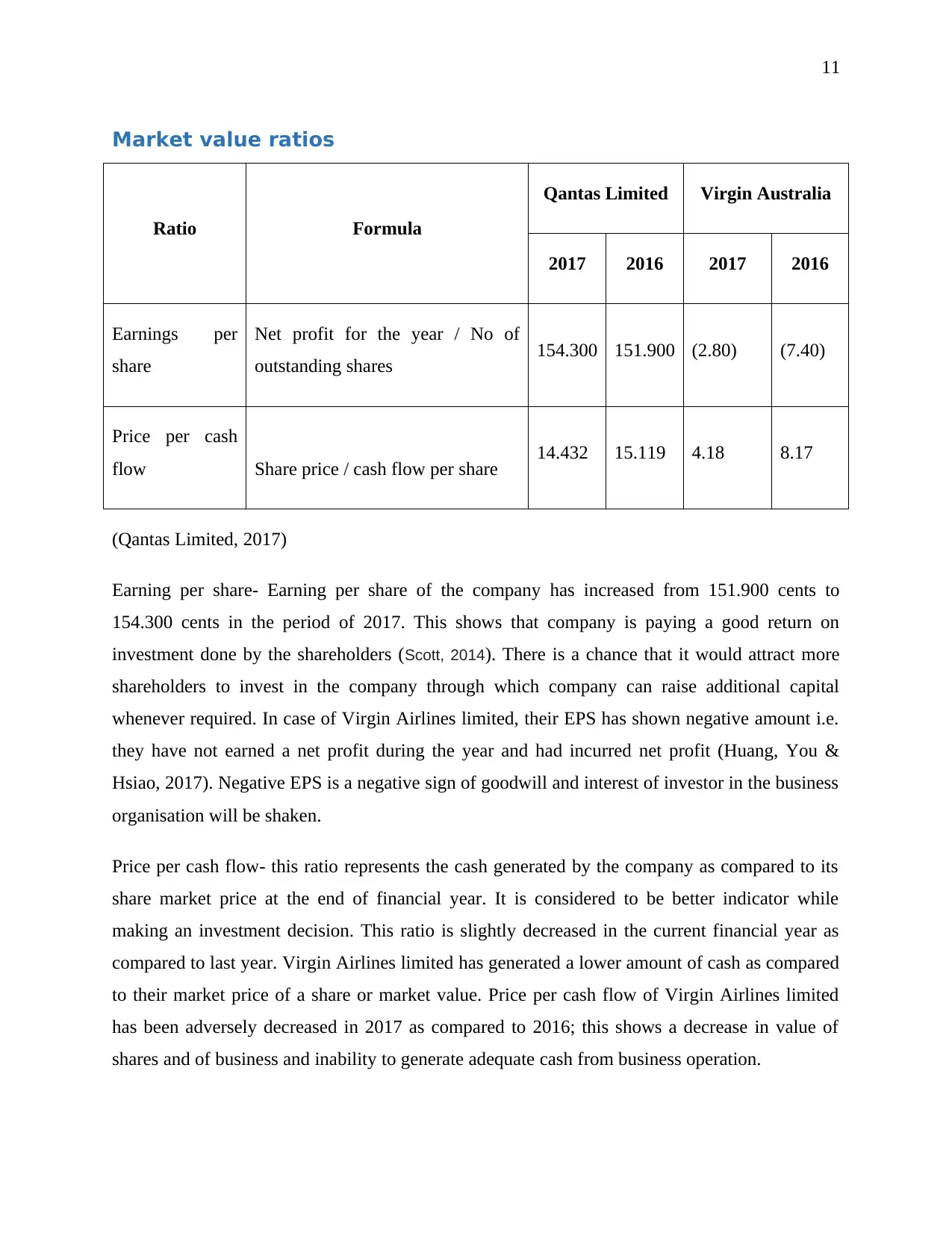
11
Market value ratios
Ratio Formula
Qantas Limited Virgin Australia
2017 2016 2017 2016
Earnings per
share
Net profit for the year / No of
outstanding shares 154.300 151.900 (2.80) (7.40)
Price per cash
flow Share price / cash flow per share 14.432 15.119 4.18 8.17
(Qantas Limited, 2017)
Earning per share- Earning per share of the company has increased from 151.900 cents to
154.300 cents in the period of 2017. This shows that company is paying a good return on
investment done by the shareholders (Scott, 2014). There is a chance that it would attract more
shareholders to invest in the company through which company can raise additional capital
whenever required. In case of Virgin Airlines limited, their EPS has shown negative amount i.e.
they have not earned a net profit during the year and had incurred net profit (Huang, You &
Hsiao, 2017). Negative EPS is a negative sign of goodwill and interest of investor in the business
organisation will be shaken.
Price per cash flow- this ratio represents the cash generated by the company as compared to its
share market price at the end of financial year. It is considered to be better indicator while
making an investment decision. This ratio is slightly decreased in the current financial year as
compared to last year. Virgin Airlines limited has generated a lower amount of cash as compared
to their market price of a share or market value. Price per cash flow of Virgin Airlines limited
has been adversely decreased in 2017 as compared to 2016; this shows a decrease in value of
shares and of business and inability to generate adequate cash from business operation.
Market value ratios
Ratio Formula
Qantas Limited Virgin Australia
2017 2016 2017 2016
Earnings per
share
Net profit for the year / No of
outstanding shares 154.300 151.900 (2.80) (7.40)
Price per cash
flow Share price / cash flow per share 14.432 15.119 4.18 8.17
(Qantas Limited, 2017)
Earning per share- Earning per share of the company has increased from 151.900 cents to
154.300 cents in the period of 2017. This shows that company is paying a good return on
investment done by the shareholders (Scott, 2014). There is a chance that it would attract more
shareholders to invest in the company through which company can raise additional capital
whenever required. In case of Virgin Airlines limited, their EPS has shown negative amount i.e.
they have not earned a net profit during the year and had incurred net profit (Huang, You &
Hsiao, 2017). Negative EPS is a negative sign of goodwill and interest of investor in the business
organisation will be shaken.
Price per cash flow- this ratio represents the cash generated by the company as compared to its
share market price at the end of financial year. It is considered to be better indicator while
making an investment decision. This ratio is slightly decreased in the current financial year as
compared to last year. Virgin Airlines limited has generated a lower amount of cash as compared
to their market price of a share or market value. Price per cash flow of Virgin Airlines limited
has been adversely decreased in 2017 as compared to 2016; this shows a decrease in value of
shares and of business and inability to generate adequate cash from business operation.

12
⊘ This is a preview!⊘
Do you want full access?
Subscribe today to unlock all pages.

Trusted by 1+ million students worldwide
1 out of 17
Related Documents
Your All-in-One AI-Powered Toolkit for Academic Success.
+13062052269
info@desklib.com
Available 24*7 on WhatsApp / Email
![[object Object]](/_next/static/media/star-bottom.7253800d.svg)
Unlock your academic potential
Copyright © 2020–2026 A2Z Services. All Rights Reserved. Developed and managed by ZUCOL.




